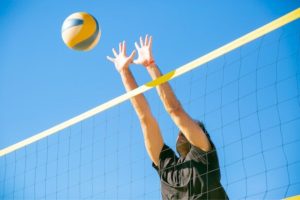Shaking hands after playing volleyball can be a bothersome experience. The adrenaline and satisfaction of an intense game still linger in your veins.

You may notice an unexpected trembling in your hands. It’s a circumstance that many volleyball players encounter. But what is the reason behind it?
Understanding why your hands are shaking after playing volleyball is crucial for your well-being, not just your game performance.
This article will explore the possible causes of the shaking hands phenomenon. We will also talk through what to do about it and effective strategies for addressing it.
It will help you enhance your volleyball experience and ensures your safety and health.
Causes of Shaking Hands After Playing Volleyball
Here are some possible reasons that cause your hands to shake after playing volleyball:
Physical Exertion and Muscle Fatigue
Playing volleyball involves rapid and repetitive movements. It requires significant physical exertion.
The constant jumping, hitting, and diving can strain your muscles which may lead to fatigue.
When muscles are tired, they cannot respond efficiently, resulting in trembling hands.
During intense gameplay, your muscles undergo repetitive contractions and extensions. It may lead to metabolic byproduct accumulation, such as lactic acid.
These byproducts production weaken muscle function, contributing to trembling or shaking hands sensation.
What to do with it:
- Rest and recovery periods between matches or training sessions. Allow your body to have sufficient time to rest and recover. The tired muscles need time to repair and rebuild, which will help reduce shaking hands.
- Incorporate strength and endurance training exercises specific to the muscles involved in volleyball, particularly the hands, forearms, and shoulders. Strengthening these muscles will enhance their endurance and reduce fatigue that causes shaking hands.
- Stretch and cool down after each session to relieve muscle tension and promote relaxation. Stretching can help prevent muscle imbalances.
- Progress gradually by increasing the intensity and duration of your volleyball training sessions. Progressive training will allow your muscles to adapt and reduce the chances of shaking hands.
- Consume proper nutrition and hydration. Always maintain a balanced diet that will provide the necessary nutrients and energy for optimal muscle function.
Increased Adrenaline and Cortisol Levels

Volleyball is a thrilling sport that can trigger your adrenaline rush during intense gameplay.
Adrenaline increases the heart rate and blood flow and releases cortisol, a stress hormone.
It can trigger physiological responses, which are heightened arousal and muscle tension that may contribute to shaky hands.
What to do about it:
- Undertake relaxation techniques, such as meditation or deep breathing, to calm the body and reduce stress levels. These techniques help counter the adrenaline and cortisol effects, promoting relaxation and reducing shaking hands.
- Implement visualization exercises to prepare for the game and minimize anxiety mentally. Try to visualize yourself executing precise movements with steady hands. It will help regulate the adrenaline and cortisol release, which may lessen the impact of shaking hands.
- Incorporate mindfulness practices to enhance focus and maintain composure during high-pressure situations. Maintain a clear and composed mindset to minimize stress and reduce your shaking hands.
- Be prepared psychologically by engaging in mental preparation before matches or training sessions. Create a pre-game routine that includes positive affirmations, mental imagery, or listening to music to help you stay focused and calm. It will reduce the anxiety that may be associated with physical symptoms like shaking hands.
- Foster a supportive team environment where athletes can rely on each other for encouragement and stress management. Building a cohesive and positive team atmosphere can help reduce anxiety and mitigate the effects of adrenaline and cortisol.
Dehydration and Electrolyte Imbalance
Strenuous physical activity in volleyball leads to sweating, resulting in fluid loss and electrolyte imbalance.
Dehydration can affect muscle function and lead to increased muscle fatigue and trembling.
Losing electrolytes causes an imbalance and disrupts normal electrical signals to muscles that cause improper muscle functions.
Proper hydration is vital for all athletes, including volleyball players.
What to do about it:
- Drink enough water before, during, and after playing volleyball to stay adequately hydrated. It helps optimal muscle function and reduces shaking hands.
- Consume electrolyte-rich fluids or sports drinks to replenish minerals lost through sweating. It can help restore the electrolyte balance in your body and support proper muscle function.
- To support appropriate muscle function, consume a balanced diet with foods rich in potassium and magnesium, such as bananas, avocados, and nuts. Consuming a varied and nutrient-dense diet helps ensure your body has an adequate supply of electrolytes for optimal muscle function.
- Avoid excessive caffeine and alcohol. Control your intake of caffeine and alcohol, as they can contribute to dehydration and cause electrolyte imbalances.
- You can monitor your urine as it can indicate your hydration status. Clear to light yellow means you are well hydrated.
Poor Technique and Excessive Tension

Incorrect technique and excessive tension in your hands and arms while playing can contribute to shaking hands.
Gripping the ball too tightly or maintaining excessive muscle tension can lead to fatigue and trembling.
What to do about it:
- Seek guidance from a volleyball coach or experienced players to learn proper techniques in gripping the ball and executing different skills. They can help refine your grip, hand position, and overall strategy, reducing unnecessary tension and improving control.
- Practice drills that focus on relaxation and fluidity of movement to develop better control over your hands. Avoid unnecessary muscle tension in your hands, arms, and shoulders. Concentrate on maintaining a loose grip on the ball while still maintaining control.
- Pay attention to your grip strength and consciously relax your hands during gameplay. Strengthening your hands and forearm muscles can improve your grip strength and stability.
- Practice maintaining a relaxed and fluid motion during gameplay. Focus on gradually developing your skills and technique over time. Avoid rushing to learn advanced techniques before mastering the fundamentals. Building a solid foundation of proper technique can help minimize tension and shaking in the hands.
- Concentrate on maintaining mental focus and concentration during gameplay. When you are mentally engaged, it can reduce pressure and enhance your overall control and coordination.
- Practice regularly to reinforce proper technique and develop muscle memory. The more you practice correct form and style, the more natural it will become, reducing the likelihood of excessive tension and shaking hands.
Underlying Medical Conditions (If Applicable)
In some cases shaking hands after playing volleyball could indicate medical condition implications.
It could be essential tremor, hyperthyroidism, Parkinson’s disease, or if you are on medication.
If you experience shaking hands persistently along with other symptoms, you must consult a healthcare professional for a proper diagnosis.
Addressing potential causes can help implement appropriate strategies for reducing or eliminating shaking hands after playing volleyball.
Remember, it’s essential to prioritize your overall health, including rest, nutrition, and technique.
It will enhance your performance on the court and allow you to enjoy the game to its fullest potential.
Conclusion
Experiencing shaking hands after playing volleyball can be both frustrating and concerning.
However, by understanding the causes and implementing effective strategies, you can address this phenomenon.
It will also improve your overall performance and well-being on the court.
Implement strategies such as proper warm-up and stretching exercises to reduce shaking hands.
Gradually increase the intensity and duration of play, maintaining hydration and balanced nutrition, strengthening hand and forearm muscles.
Also, utilize relaxation techniques, improve technique and reduce tension, and seek medical advice if necessary.
By addressing the causes, implementing prevention strategies, and prioritizing recovery, you can regain control over your hands.
It also enhances your performance, and you thoroughly enjoy the volleyball game.
So step onto the court confidently, knowing you have the knowledge and tools to conquer shaking hands and excel in your volleyball journey.

When I was in high school, I was the best at running. Running for me is not a trend, this is my whole life. I jog every morning, without exceptions: I don’t skip mornings on vacations or business trips. My friends are also sports fans: I went to my best friend’s yoga class for the first time about three years ago.
Since then, I’ve been practicing regularly, and we have also made several yoga trips to India. For my last birthday, I got a skateboard as a present from her. Now we’re both taking personal classes with a coach, and it’s 100% fun!





